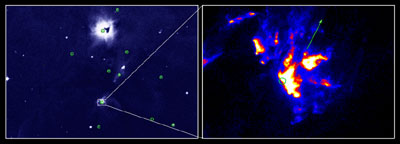October 18, 2001
A type of celestial object that has long stumped astronomers has been found to emit X-rays, thus proving a theory of how the objects form.
Dr. Steven Pravdo of NASA's Jet Propulsion Laboratory, Pasadena, Calif., and other scientists have concluded that these objects, called Herbig Haro objects, are produced by high velocity shocks. Pravdo is the lead author of a paper published in the Oct. 18 issue of the journal Nature.
Herbig Haro objects are found in regions where new stars are forming. They are nebulas, or dust and gas clouds. They form when high-velocity gas emitted from young stars collides with clouds of interstellar material. The collision heats the gas in the surrounding nebula to sufficiently high temperatures to produce X-rays.
Observations for the past 20 years showed no evidence of X-ray emission from these objects, which are named for astronomers George Herbig and Guillermo Haro. Previous instruments lacked the resolution and sensitivity necessary to 'see' these X-rays. The discovery of the X-ray emissions was possible through the very powerful Advanced CCD Imaging Spectrometer on NASA's Chandra X-ray Observatory, which has been in orbit since 1999.
On Oct. 8, 2000, astrophysicists used the instrument to study HH2, one of the brightest and closest Herbig Haro objects in the Orion Nebula. They determined that HH2 contains shock-heated material with a temperature of about 1 million degrees Kelvin. Pravdo and his team used three criteria to rule out the possibility that the emissions came from any other source. First, Chandra's high spatial resolution pinpointed the location of the X-rays at HH2. Second, the X-rays appeared to be covering a region bigger than a star. Third, the temperature of the X-rays was about 1 million degrees, cooler than nearby X-ray stars. One million degrees is about the temperature expected if material moving at about 300 kilometers per second (about 600,000 miles per hour) collides. At this speed, you could go from Los Angeles to San Diego and back in one second.
The principal investigator of the Advanced CCD Imaging Spectrometer, Dr. Gordon Garmire of Pennsylvania State University, University Park, is a co-author of the paper. Other co-authors include Drs. Yohko Tsuboi, Yoshitomo Maeda and Eric Feigelson, all from Pennsylvania State University, and Dr. John Bally from the University of Colorado, Boulder. The Advanced CCD Imaging Spectrometer X-ray camera was developed for NASA by Pennsylvania State University and the Massachusetts Institute of Technology, Cambridge, Mass. NASA's Marshall Space Flight Center in Huntsville, Ala., manages the Chandra program. TRW, Inc., Redondo Beach, Calif., is the prime contractor for the spacecraft. The Smithsonian's Chandra X-ray Center controls science and flight operations from Cambridge, Mass.
Images associated with this release are available on the World Wide Web at:
The Chandra X-ray Observatory is managed for NASA by the Smithsonian Astrophysical Observatory, Cambridge, Mass. JPL is managed for NASA by the California Institute of Technology in Pasadena.



